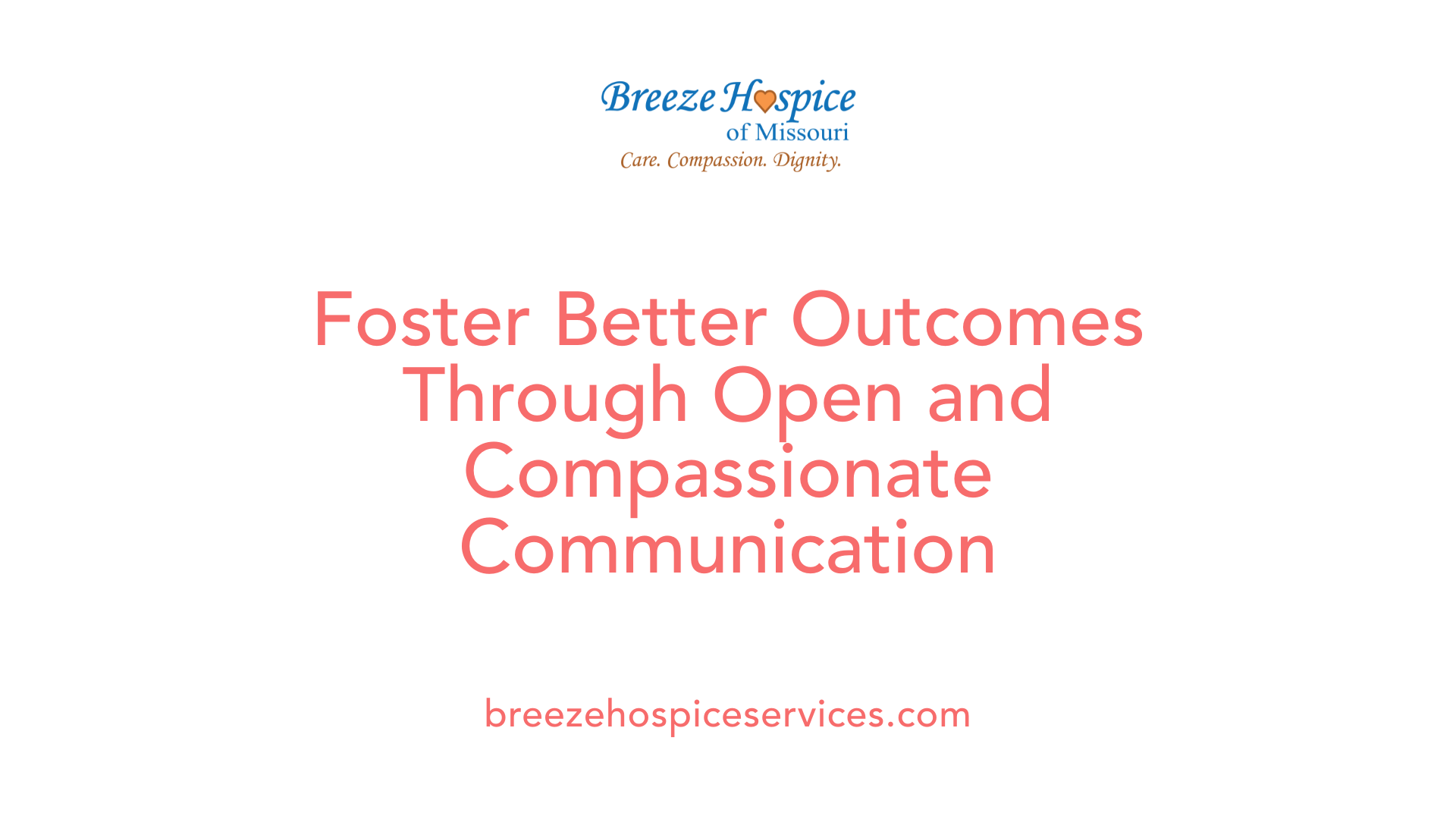How Hospice Nurses Work Alongside Aides to Provide Comprehensive Care
May 20, 2025
The Integral Role of Teamwork in Hospice End-of-Life Care

Understanding the Collaborative Effort in Hospice Settings
Hospice care exemplifies a comprehensive, team-oriented approach to end-of-life support, where physicians, nurses, aides, social workers, spiritual counselors, and volunteers work together seamlessly to ensure patients experience dignity, comfort, and holistic well-being. This article explores how hospice nurses and aides collaborate within this interdisciplinary framework to deliver personalized, compassionate care tailored to each patient's unique needs, emphasizing the importance of communication, organization, and specialized training.
Roles and Responsibilities of Hospice Nurses and Aides
What are the roles and responsibilities of hospice nurses and aides in comprehensive patient care?
Hospice nurses and aides are essential members of the interdisciplinary team, working together to provide compassionate and comprehensive care tailored to patients nearing the end of life.
Hospice nurses hold the primary responsibility for evaluating and managing symptoms, administering medications, monitoring vital signs, and adjusting treatment plans as needed. They ensure effective pain control and symptom relief, using assessment tools like the Numeric Pain Rating Scale and FLACC scale. Nurses also coordinate with physicians and other team members to optimize care, educate families about disease progression, and support emotional well-being.
Complementing the nurses, home health aides assist with basic personal care and daily activities. They help with bathing, dressing, grooming, feeding, and ensuring the patient's comfort and dignity. Aides also support mobility, reposition patients to prevent pressure sores, and perform light housekeeping tasks that promote a safe and clean environment.
Both nurses and aides maintain ongoing communication with the entire care team, reporting any changes in the patient’s condition and discussing adjustments needed. They also provide emotional support through companionship, active listening, and creating a peaceful environment. Education is a vital part of their role, helping families understand medication management, symptom control strategies, and caregiving techniques.
Overall, these professionals work collaboratively, ensuring that patients experience comfort and dignity, while also supporting families through difficult transitions. Their combined efforts uphold the holistic approach of hospice care, emphasizing emotional, spiritual, and physical comfort during this sensitive period.
Team Collaboration and Communication

How do hospice care team members coordinate and collaborate on patient care?
Effective coordination among hospice team members is vital to delivering comprehensive and personalized end-of-life care. These professionals—including physicians, nurses, social workers, chaplains, aides, therapists, and volunteers—work together through structured, interdisciplinary communication.
Regular team meetings are a cornerstone of this collaboration. During these sessions, care teams review patients’ conditions, update care plans, assign responsibilities, and discuss any new concerns. This organized approach ensures everyone stays informed and aligned with patient needs and goals.
Shared care plans and documentation are crucial tools that facilitate transparency and accountability. These plans outline medical treatments, symptom management strategies, spiritual support, and psychosocial resources, allowing team members to access up-to-date information easily.
Interdisciplinary communication techniques include case conferences, electronic health records, and direct verbal exchanges. Using secure digital platforms helps maintain continuity, especially when team members work across different locations or shifts.
Family involvement further enhances team collaboration. When families participate in planning discussions, care strategies align more closely with the patient’s wishes and preferences. Open communication with families also provides emotional reassurance and valuable insights into the patient's daily experiences.
Despite the structured framework, some challenges persist. Studies show that while perceptions of teamwork and communication are generally positive, actual practice can sometimes fall short, with issues like miscommunication or role ambiguity emerging.
To improve these areas, many hospice programs adopt advanced models like Entrustable Professional Activities (EPAs)—which clearly define professional tasks and responsibilities—and leverage digital communication tools for real-time updates and feedback. These strategies promote a cohesive, efficient team environment focused on compassionate, patient-centered care.
In summary, seamless collaboration in hospice relies on scheduled meetings, shared documentation, effective communication methods, and family participation. These elements help create a supportive environment where the entire care team functions harmoniously to honor the patient's end-of-life wishes.
Organizational Structure of Hospice Teams
 Hospice care teams are structured as multidisciplinary groups, bringing together professionals from various fields to address the comprehensive needs of terminally ill patients. The core members include registered nurses, hospice physicians or medical directors, social workers, chaplains, aides, and volunteers. Each role contributes specialized skills, working collaboratively through structured documentation and regular team meetings to ensure personalized and holistic care.
Hospice care teams are structured as multidisciplinary groups, bringing together professionals from various fields to address the comprehensive needs of terminally ill patients. The core members include registered nurses, hospice physicians or medical directors, social workers, chaplains, aides, and volunteers. Each role contributes specialized skills, working collaboratively through structured documentation and regular team meetings to ensure personalized and holistic care.
Within this framework, designated coordinators such as the Bereavement Coordinator and Volunteer Coordinator play crucial roles. They support families through grief counseling after a patient’s passing and organize volunteer activities that provide companionship and emotional support.
Care is delivered across different settings, which can include the patient’s home, inpatient facilities, or nursing homes. Based on the patient’s condition, hospice services are provided at various levels, from routine home visits to more intensive inpatient or respite care, adapting to the evolving needs of the patient.
Effective teamwork relies on clear protocols for communication, role clarity, and coordination. Regular interdisciplinary meetings foster collaboration, allowing team members to review patient progress and update care plans. This organization ensures that physical, emotional, social, and spiritual needs are addressed seamlessly.
Overall, the structure of a hospice team emphasizes flexible yet organized frameworks, promoting comprehensive, patient-centered care that respects individual wishes and enhances quality of life in final months and days.
Training and Education for Effective Collaboration
 In hospice care, the collaboration between nurses, aides, and other team members relies heavily on specialized training and ongoing education. These programs ensure that each team member can perform their roles effectively while fostering a cohesive interdisciplinary approach.
In hospice care, the collaboration between nurses, aides, and other team members relies heavily on specialized training and ongoing education. These programs ensure that each team member can perform their roles effectively while fostering a cohesive interdisciplinary approach.
Hospice nurses and aides pursue certifications like the Hospice and Palliative Care Certification, which validate their expertise in managing complex symptoms and providing compassionate care. Beyond initial certification, continuous education is vital. It includes courses focused on symptom management techniques, such as controlling nausea, shortness of breath, and pain, as well as communication skills for discussing sensitive issues with patients and families.
Several organizations support hospice teams through educational resources. For example, the MJHS Institute offers live and on-demand webinars, multimedia modules, and multilingual resources, all designed to improve clinical skills and team communication. The Alliance for Care at Home provides similar training aimed at enhancing interdisciplinary understanding.
These educational initiatives also emphasize documentation accuracy, safety protocols, and teamwork strategies. Training sessions often involve simulations and case studies, helping staff develop problem-solving skills in real-world scenarios. The goal is to improve patient outcomes by ensuring all team members are current with clinical standards and best practices.
By investing in ongoing education, hospice teams strengthen their ability to provide holistic, patient-centered care. This training ensures that nurses, aides, social workers, and chaplains work seamlessly together—addressing not just physical symptoms but also emotional, social, and spiritual needs.
Overall, continuous professional development plays a crucial role in maintaining high-quality hospice services. It fosters a culture of collaboration, ensuring that every team member is equipped with the knowledge and skills necessary for compassionate and effective end-of-life care.
Providing Holistic End-of-Life Care Through Team Efforts

What are best practices for providing holistic, end-of-life care through team efforts?
Providing comprehensive, compassionate end-of-life care requires a coordinated team approach that addresses all facets of a patient’s well-being. A central strategy is using a biopsychosocial-spiritual model, which ensures that physical symptoms, emotional health, social connections, and spiritual needs are all considered.
The interdisciplinary team typically includes physicians, nurses, social workers, chaplains, therapists, and complementary practitioners. These professionals collaborate to develop personalized care plans that manage pain and symptoms, support emotional health, and honor spiritual beliefs. Regular communication and team meetings facilitate a shared understanding of each patient's evolving needs.
Advance care planning is integral, enabling patients to articulate their preferences about treatments and end-of-life wishes early in the care process. Ongoing discussions ensure that care aligns with patient values, with team members guiding families through decisions about life-sustaining devices and interventions.
Incorporating holistic therapies such as massage, aromatherapy, and guided spiritual counseling can significantly enhance comfort, reduce anxiety, and bring peace to patients and families. These practices aim to maintain dignity and foster a sense of calm in the final stages of life.
Family-centered care emphasizes involving loved ones in decision-making, providing them with education and emotional support throughout the journey. Clear communication about prognosis, treatment options, and symptom management helps families feel engaged and reassured.
Ultimately, best practices promote a care environment rooted in empathy, respect, and open dialogue, ensuring that each patient’s final days are lived with dignity, comfort, and fulfillment.
Impact of Effective Communication on Patient Outcomes

How does effective communication within hospice teams enhance patient care?
Effective communication plays a crucial role in augmenting the quality of hospice care. When team members—including physicians, nurses, social workers, chaplains, aides, and volunteers—share information openly, they can implement well-coordinated, personalized care plans. This ensures that each patient's unique physical, emotional, social, and spiritual needs are addressed holistically.
Open dialogue and active listening foster trust and strengthen relationships among team members and with patients and their families. This trust makes it easier to support emotional well-being, handle sensitive issues, and conduct difficult conversations with compassion. For instance, honest discussions about prognosis and treatment options help patients and families make informed choices aligned with their values.
Regular interdisciplinary meetings, along with efficient use of electronic health records, ensure seamless care coordination. These practices facilitate timely interventions, symptom management, and adjustments to care plans. Moreover, transparent communication about medication, care procedures, and expectations supports patient comfort and dignity.
Family involvement is another vital aspect. When caregivers participate actively, sharing observations and preferences, the team can tailor interventions better. This collaborative approach not only improves symptom control but also enhances emotional support, reducing distress for patients and families.
In managing difficult conversations, such as discussing prognosis or end-of-life wishes, communication strategies like empathy, honesty, and patience are essential. Such conversations, while challenging, are handled more effectively when team members and caregivers communicate with compassion and respect.
Overall, effective communication creates an environment of trust, understanding, and support. It enables hospice teams to deliver care that respects patient wishes, alleviates suffering, and maintains dignity—contributing significantly to positive patient outcomes and higher satisfaction with hospice care.
More about effective communication in hospice teams and patient care
You can find extensive resources and research on this topic by searching for "Effective communication in hospice teams and patient care" online. This highlights the importance of clear, compassionate, and collaborative communication practices in end-of-life care settings.
A Compassionate and Collaborative End-of-Life Care
Hospice care is inherently a team effort that relies on coordinated, compassionate, and holistic approaches to support patients and their families during the most challenging times. The collaboration of nurses, aides, physicians, social workers, chaplains, and volunteers ensures that end-of-life care addresses every facet of a patient’s well-being—physical, emotional, social, and spiritual. Through ongoing training, clear communication, and mutual respect, hospice teams foster an environment of trust, dignity, and comfort. Ultimately, the effective partnership between hospice nurses and aides exemplifies the essence of compassionate care, bringing peace and support to those nearing the end of life and providing vital reassurance to their loved ones.
References
- How Hospice Staff Works Together to Provide Comprehensive Care
- What Does A Hospice Nurse Do? A Closer Look At Their Role In ...
- Vital Role of Certified Nursing Assistants in Hospice Care
- The Roles of a Hospice Nurse and Care Team
- A Day in the Life of a Hospice Nurse - VITAS Healthcare
- How Our Hospice Nurses, Aides, and Chaplains Bring Care to Life's ...
- Hospice Home Care | Baxter Health
- What Is Hospice Care? - Cleveland Clinic



































































































